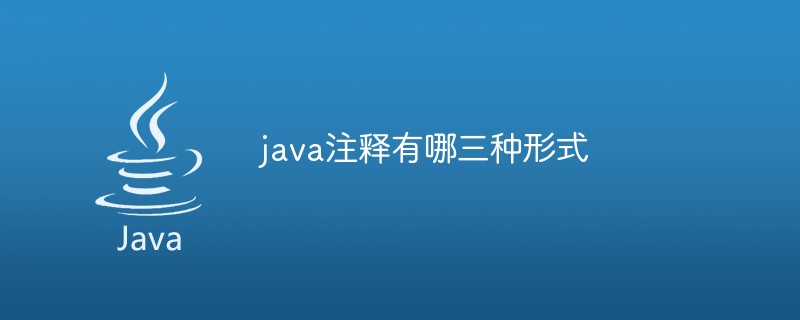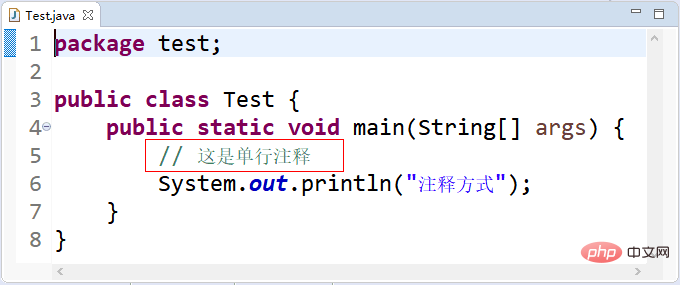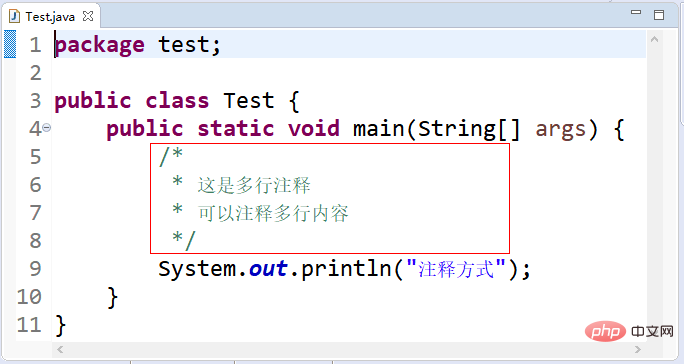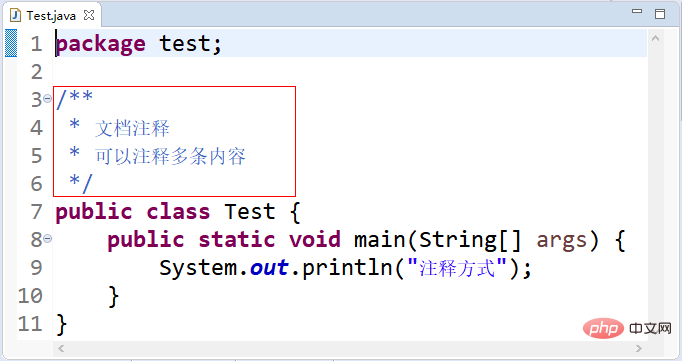What are the three forms of java comments?
*/". 3. Document comments, included between "/**"and"*/", can also comment on multiple lines of content. They are generally used on classes, methods and variables to describe their functions. The syntax is "/**", the next one will also be scanned"*/".Three forms of java comments: 1. Single-line comments, marked with double slashes "//", can only comment one line of content, and are used in places with little comment information. The syntax is "//"and" ". 2. Multi-line comments, included between "/*Annotation content*/", can comment on many lines of content, the syntax is "/*
"and"

The operating environment of this tutorial: windows7 system, java8 version, DELL G3 computer.
Comments are descriptions of the programming language, which facilitate communication between developers and users and facilitate understanding of the program. Comments are not programming statements and therefore are ignored by the compiler. Java supports three comment methods:
1) Single-line comment
Identified by double slashes "
", only one line of content can be commented, and it is used in places with little information content. Open Eclipse and use single-line comments in the Java code, as shown in Figure 1. 
Figure 1 Single-line comment
2) Multi-line comment is included in "/* "and"
", many lines of content can be commented. For better readability, generally no comment information is written in the first and last lines (this is also more beautiful and beautiful), as shown in Figure 2.
Note: Multi-line comments can nest single-line comments, but multi-line comments and document comments cannot be nested. 
Figure 2 Multi-line comments
3) Documentation comments are included in "/**## "#&*/

In Java, a line of comments is identified by double slashes "//"; multi-line comments are included between "/*&*/"; documentation comments are included between " /**&*/"between.
When the compiler executes to "//", it will ignore all text after the line "//"; when it executes to "/*", it will scan the next "*/" and ignore "/* &*/"; when executing to "/**&*/" and ignore any text content between "/**&*/".
For more programming-related knowledge, please visit: Programming Teaching
! ! ###The above is the detailed content of What are the three forms of java comments?. For more information, please follow other related articles on the PHP Chinese website!

Hot AI Tools

Undresser.AI Undress
AI-powered app for creating realistic nude photos

AI Clothes Remover
Online AI tool for removing clothes from photos.

Undress AI Tool
Undress images for free

Clothoff.io
AI clothes remover

AI Hentai Generator
Generate AI Hentai for free.

Hot Article

Hot Tools

Notepad++7.3.1
Easy-to-use and free code editor

SublimeText3 Chinese version
Chinese version, very easy to use

Zend Studio 13.0.1
Powerful PHP integrated development environment

Dreamweaver CS6
Visual web development tools

SublimeText3 Mac version
God-level code editing software (SublimeText3)

Hot Topics
 Square Root in Java
Aug 30, 2024 pm 04:26 PM
Square Root in Java
Aug 30, 2024 pm 04:26 PM
Guide to Square Root in Java. Here we discuss how Square Root works in Java with example and its code implementation respectively.
 Perfect Number in Java
Aug 30, 2024 pm 04:28 PM
Perfect Number in Java
Aug 30, 2024 pm 04:28 PM
Guide to Perfect Number in Java. Here we discuss the Definition, How to check Perfect number in Java?, examples with code implementation.
 Random Number Generator in Java
Aug 30, 2024 pm 04:27 PM
Random Number Generator in Java
Aug 30, 2024 pm 04:27 PM
Guide to Random Number Generator in Java. Here we discuss Functions in Java with examples and two different Generators with ther examples.
 Armstrong Number in Java
Aug 30, 2024 pm 04:26 PM
Armstrong Number in Java
Aug 30, 2024 pm 04:26 PM
Guide to the Armstrong Number in Java. Here we discuss an introduction to Armstrong's number in java along with some of the code.
 Weka in Java
Aug 30, 2024 pm 04:28 PM
Weka in Java
Aug 30, 2024 pm 04:28 PM
Guide to Weka in Java. Here we discuss the Introduction, how to use weka java, the type of platform, and advantages with examples.
 Smith Number in Java
Aug 30, 2024 pm 04:28 PM
Smith Number in Java
Aug 30, 2024 pm 04:28 PM
Guide to Smith Number in Java. Here we discuss the Definition, How to check smith number in Java? example with code implementation.
 Java Spring Interview Questions
Aug 30, 2024 pm 04:29 PM
Java Spring Interview Questions
Aug 30, 2024 pm 04:29 PM
In this article, we have kept the most asked Java Spring Interview Questions with their detailed answers. So that you can crack the interview.
 Break or return from Java 8 stream forEach?
Feb 07, 2025 pm 12:09 PM
Break or return from Java 8 stream forEach?
Feb 07, 2025 pm 12:09 PM
Java 8 introduces the Stream API, providing a powerful and expressive way to process data collections. However, a common question when using Stream is: How to break or return from a forEach operation? Traditional loops allow for early interruption or return, but Stream's forEach method does not directly support this method. This article will explain the reasons and explore alternative methods for implementing premature termination in Stream processing systems. Further reading: Java Stream API improvements Understand Stream forEach The forEach method is a terminal operation that performs one operation on each element in the Stream. Its design intention is






